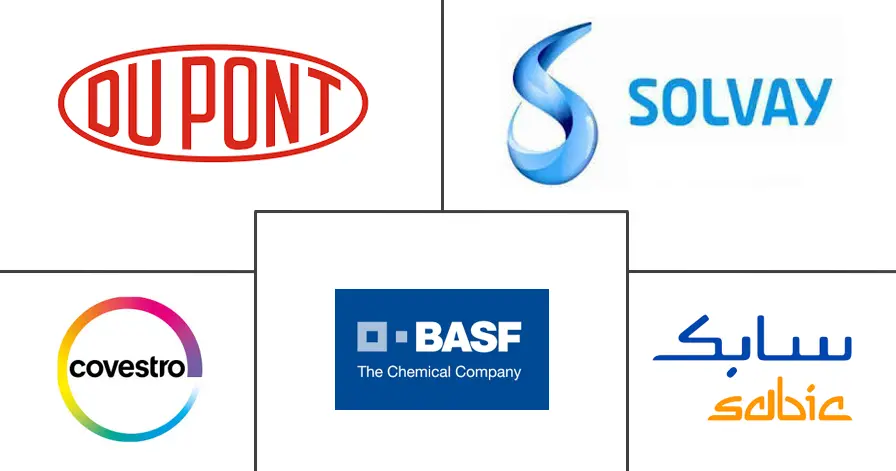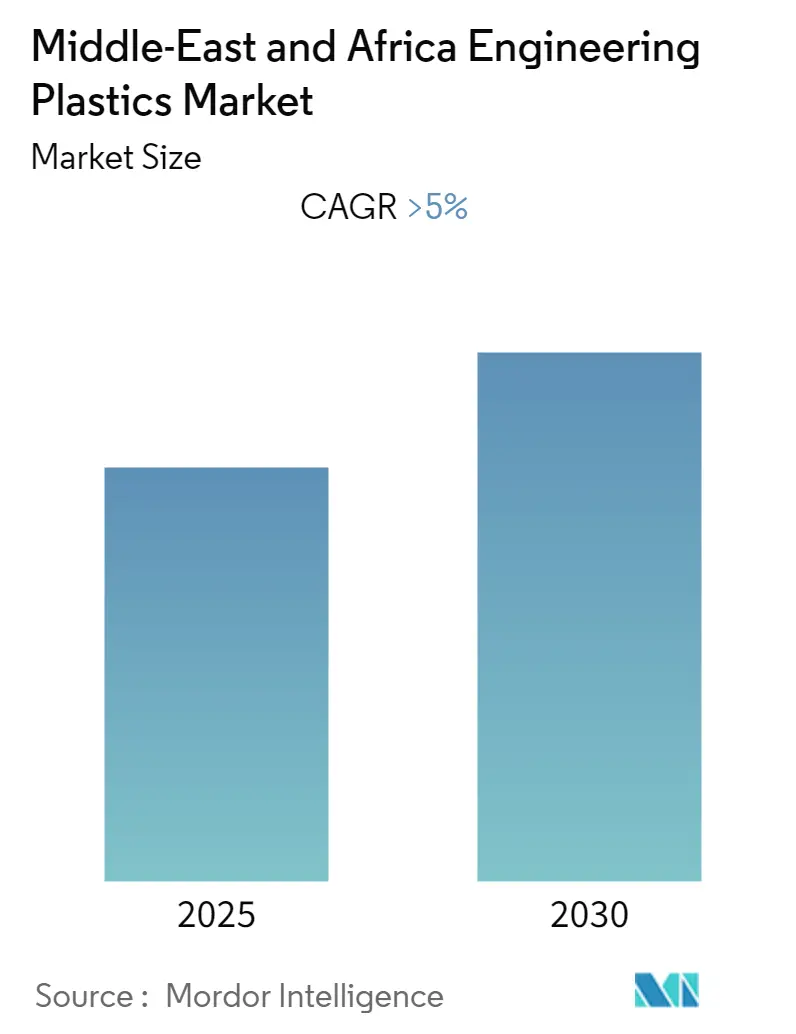
Middle-East and Africa Engineering Plastics Market Analysis by Mordor Intelligence
The Middle-East and Africa Engineering Plastics Market is expected to register a CAGR of greater than 5% during the forecast period.
- Growing purchasing power in the counties and engineering plastics replacing traditional materials are driving the market growth.
- Volatility in raw material prices is expected to hinder the market growth.
- Introduction of green vehicles as a key to future growth is expected to increase the opportunity for the market.
Middle-East and Africa Engineering Plastics Market Trends and Insights
Polyethylene Terephthalate (PET): The Most Used Engineering Plastic
- Polyethylene terephthalate (PET) is a thermoplastic polyester engineering resin. PET resins are known for their excellent melt flow characteristics, close molding tolerances, and high productivity from multi-cavity molds. Due to its broad mechanical and electrical properties, PET is often used to replace metals in motor housings, switches, sensors, and other electrical applications.
- PET and polyolefins are the most widely used materials in the plastic packaging industry. Some of the major properties of PET as a packaging material are recyclability, strength, and versatility, which drive the demand for these products.
- These products mainly include take-out containers, frozen foods, carbonated drinks and juices, ketchup, bottled water, jars, and baked good containers. They are also used in the food industry for clamshells, deli containers, as well as microwave food trays.
- PET also has great barrier properties that protect and preserve the contents of the product. PET maintains the fizz in carbonated soft drinks, the vitamins in juices, and the color in ketchup. In other words, it protects products and keeps them on the shelves and out of the rubbish bin, for a longer period.
- With an increasing demand for beverage packaging and a lack of better substitute for PET resin for this application, the demand for PET is projected to increase over the forecast period.
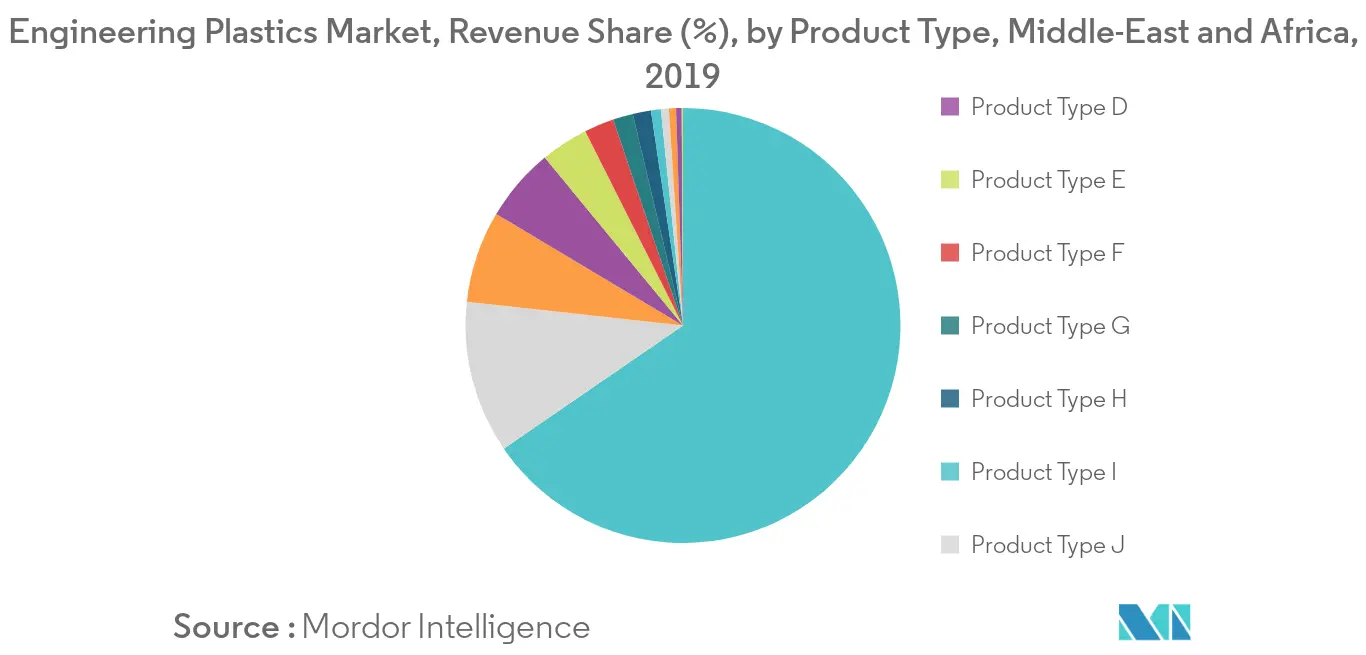
Saudi Arabia Country to Dominate the Market
- Saudi Arabia is the largest producer of engineering plastics among the Middle East countries, taking into account the current existing and upcoming production facilities.
- The healthcare industry in Saudi Arabia accounts to the largest expenditure in the GCC region, and there is a rising demand for the increase in hospital bed capacity and long-term care centers. The increasing healthcare expenditure in the country, along with the privatization of several public hospitals in the country are expected to drive the demand for healthcare equipment in the country. This in turn, is expected to increase the demand for engineering plastics at a moderate rate over the forecast period.
- The packaging sector in Saudi Arabia is expanding at a rapid rate, owing to the increasing demand from pharmaceutical industry. The innovations in the packaging sector (for cosmetics and pharmaceuticals) are supporting the consumption of engineering plastics in the country.
- There is an increase in the constructions of hotels, recreational facilities, and other public infrastructure in the country, in order to cater to the increasing number of tourists.
- Government initiatives, such as the Saudi Arabia Vision 2030 are expected to support the growth of the commercial building activities at a significant growth, in the coming years. In addition, the upcoming Dubai Expo 2020 is driving the commercial construction activities in the country, which is a positive factor for the consumption of engineering plastics in the country.
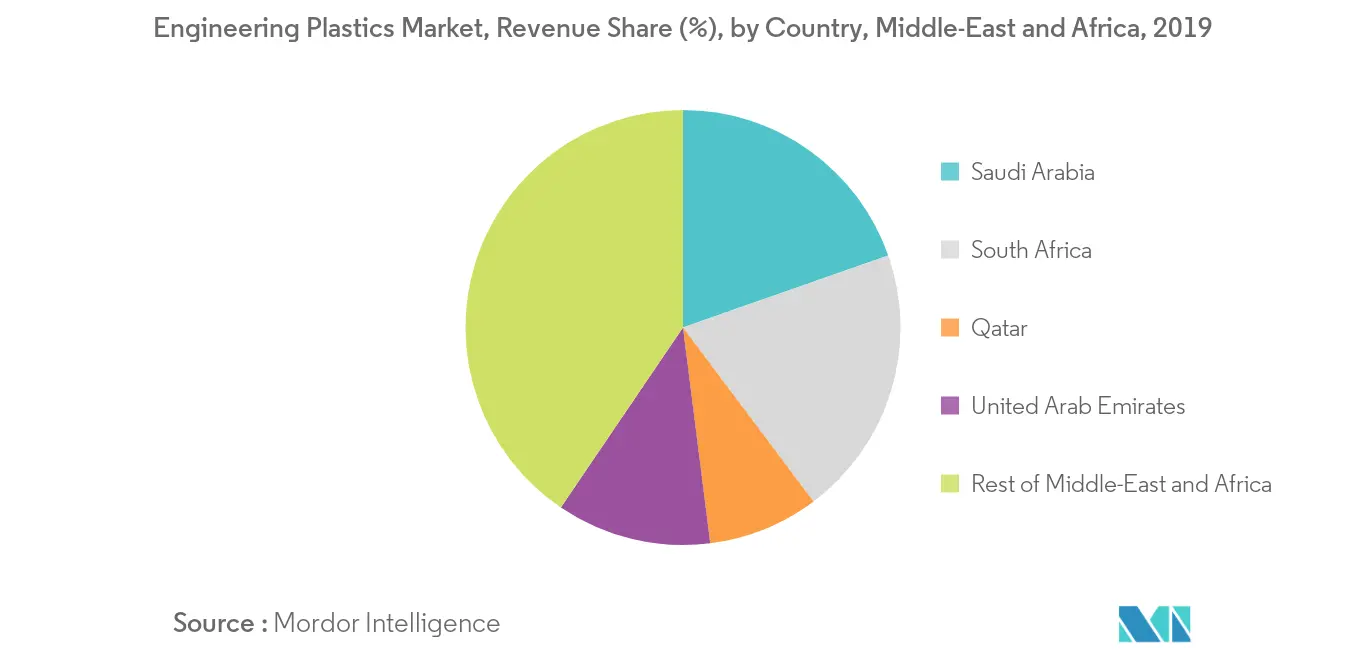
Competitive Landscape
The Middle-East and Africa engineering plastics market is partially fragmented in nature with the presence of many players in the market. Some of the major companies in Middle-East and Africa engineering plastics market includes BASF SE, SABIC, Solvay, Covestro AG, and DuPont, among others.
Middle-East and Africa Engineering Plastics Industry Leaders
BASF SE
SABIC
Solvay
Covestro AG
DuPont
- *Disclaimer: Major Players sorted in no particular order
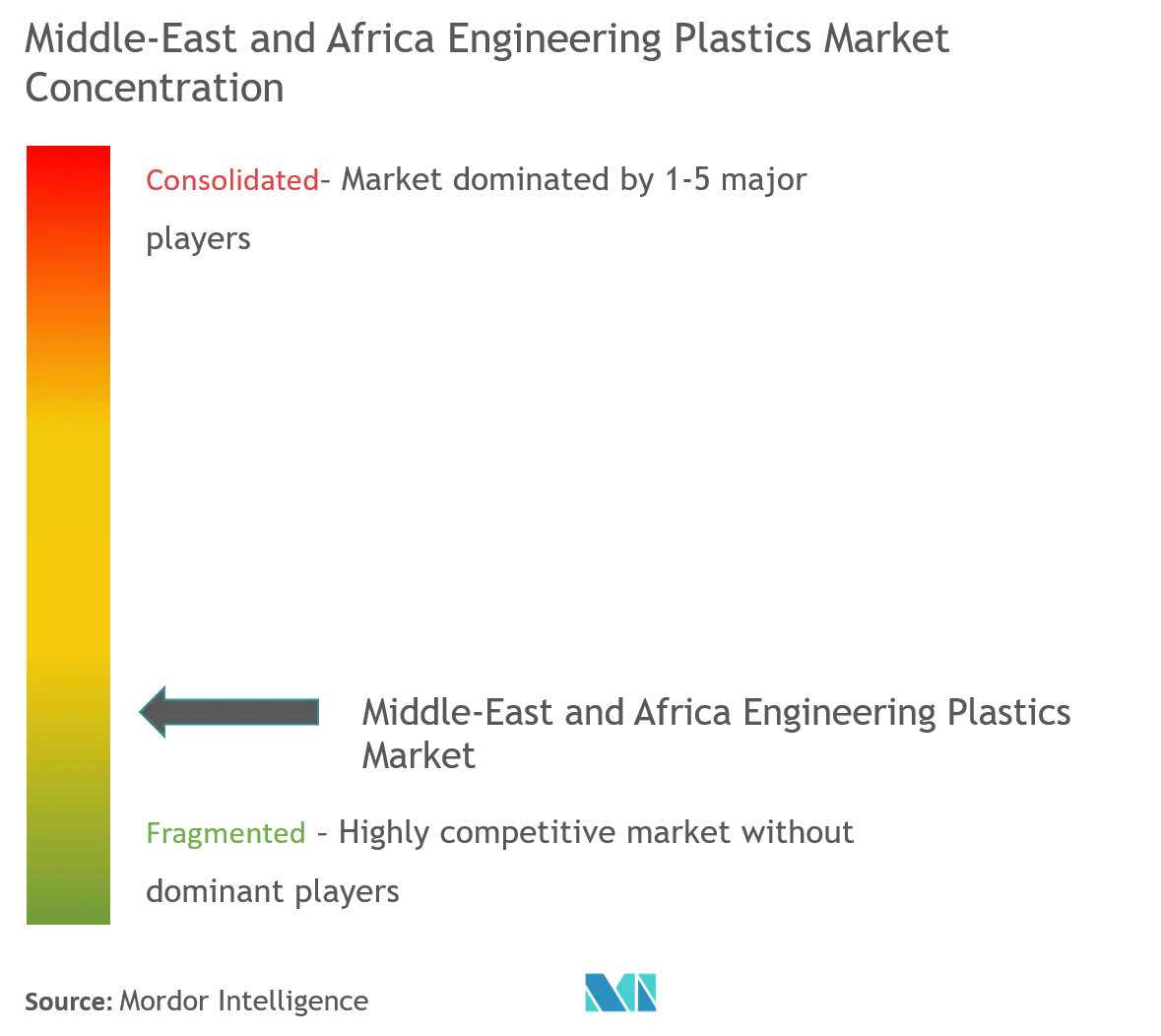
Middle-East and Africa Engineering Plastics Market Report Scope
The Middle-East and Africa Engineering Plastics Market report includes:
| Fluoropolymers |
| Polycarbonate (PC) |
| Polyethylene Terephthalate (PET) |
| Polybutylene Terephthalate (PBT) |
| Polyacetal/ Polyoxymethylene |
| Polymethyl Methacrylate (PMMA) |
| Polyphenylene Oxide |
| Polyphenylene Sulfide (PPS) |
| Styrene Copolymers (ABS & SAN) |
| Liquid Crystal Polymers (LCP) |
| Polyether Ether Ketone (PEEK) |
| Polyimides (PI) |
| Polyamides |
| Automotive and Transportation |
| Building and Construction |
| Consumer Goods |
| Electrical and Electronics |
| Industrial and Machinery |
| Packaging |
| Medical |
| Saudi Arabia |
| South Africa |
| Qatar |
| United Arab Emirates |
| Rest of Middle-East and Africa |
| Product Type | Fluoropolymers |
| Polycarbonate (PC) | |
| Polyethylene Terephthalate (PET) | |
| Polybutylene Terephthalate (PBT) | |
| Polyacetal/ Polyoxymethylene | |
| Polymethyl Methacrylate (PMMA) | |
| Polyphenylene Oxide | |
| Polyphenylene Sulfide (PPS) | |
| Styrene Copolymers (ABS & SAN) | |
| Liquid Crystal Polymers (LCP) | |
| Polyether Ether Ketone (PEEK) | |
| Polyimides (PI) | |
| Polyamides | |
| Application | Automotive and Transportation |
| Building and Construction | |
| Consumer Goods | |
| Electrical and Electronics | |
| Industrial and Machinery | |
| Packaging | |
| Medical | |
| Geography | Saudi Arabia |
| South Africa | |
| Qatar | |
| United Arab Emirates | |
| Rest of Middle-East and Africa |
Key Questions Answered in the Report
What is the current Middle-East and Africa Engineering Plastics Market size?
The Middle-East and Africa Engineering Plastics Market is projected to register a CAGR of greater than 5% during the forecast period (2025-2030)
Who are the key players in Middle-East and Africa Engineering Plastics Market?
BASF SE, SABIC, Solvay, Covestro AG and DuPont are the major companies operating in the Middle-East and Africa Engineering Plastics Market.
Which is the fastest growing region in Middle-East and Africa Engineering Plastics Market?
Middle-East and Africa is estimated to grow at the highest CAGR over the forecast period (2025-2030).
Which region has the biggest share in Middle-East and Africa Engineering Plastics Market?
In 2025, the Middle-East and Africa accounts for the largest market share in Middle-East and Africa Engineering Plastics Market.
What years does this Middle-East and Africa Engineering Plastics Market cover?
The report covers the Middle-East and Africa Engineering Plastics Market historical market size for years: 2019, 2020, 2021, 2022, 2023 and 2024. The report also forecasts the Middle-East and Africa Engineering Plastics Market size for years: 2025, 2026, 2027, 2028, 2029 and 2030.
Page last updated on:
Middle-East and Africa Engineering Plastics Market Report
Statistics for the 2025 Middle-East and Africa Engineering Plastics market share, size and revenue growth rate, created by Mordor Intelligence™ Industry Reports. Middle-East and Africa Engineering Plastics analysis includes a market forecast outlook for 2025 to 2030 and historical overview. Get a sample of this industry analysis as a free report PDF download.
